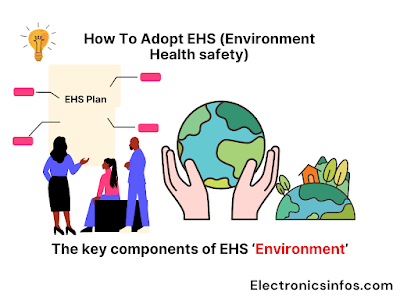What is EHS(Environment Health Safety)?
EHS stands for Environment, Health, and Safety. It is a discipline that focuses on protecting the environment, promoting the health and well-being of individuals. It ensures safety in various settings such as workplaces, communities, and public spaces. EHS encompasses activities and practices to identify, evaluate, and manage potential risks and hazards to prevent accidents, injuries, and illnesses.
The key components of EHS include
Environment
Health
Health focuses on protecting the health and well-being of workers from workplace hazards and risks. It involves identifying workplace hazards that can adversely affect employees' physical, mental, and emotional health. Health-related EHS initiatives include ergonomic evaluations, occupational health programs, health promotion campaigns, and wellness programs.
 |
| How To Adopt EHS (environment health safety) |
Safety
- Physical hazards (such as machinery, equipment, and slip/trip hazards),
- chemical hazards (such as hazardous substances and chemical spills),
- biological hazards (such as pathogens and biohazards),
- ergonomic hazards (such as poor workstation design and repetitive motions),
- psychosocial hazards (such as workplace stress and bullying).
Where is EHS(Environment Health Safety) applicable?
How To Adopt EHS (Environment Health Safety)?
- Commitment from Top Management
- Establish an EHS Policy
- Conduct Risk Assessments
- Develop EHS Programs and Procedures
- Provide Training and Education
- Implement Monitoring and Reporting Systems
- Foster Employee Engagement and Participation
- Continuously Improve
- External Engagement
- Communication and Transparent
Steps to Adopt Environment Health and Safety
- EHS begins with a clear commitment from top management. Leadership must demonstrate their dedication to creating a safe and healthy work environment and minimizing environmental impacts. This commitment should be communicated throughout the organization to ensure support and engagement from all levels.
- Develop a comprehensive EHS policy that outlines the organization's commitment to EHS and sets the direction for EHS initiatives. The policy should include goals, objectives, and guidelines for managing EHS aspects within the organization.
- Perform thorough risk assessments to identify potential hazards and risks in the workplace. This includes assessing physical, chemical, biological, and ergonomic hazards.
- Create programs and procedures to address specific EHS areas such as occupational health and safety, environmental management, emergency preparedness, and sustainability.
- Train employees at all levels on EHS policies, procedures, and practices. Provide specific training on hazard identification, safe work practices, emergency response, and any specialized EHS requirements relevant to job roles.
- Establish systems to monitor EHS performance and compliance. Regularly collect data on incidents, near-misses, environmental impacts, and other relevant metrics. Analyze this data to identify trends, areas for improvement, and corrective actions.
- Encourage employees to actively participate in EHS initiatives. Involve them in hazard identification, risk assessments, and the development of safe work practices.
- Foster a culture of continuous improvement by regularly reviewing and evaluating EHS programs and procedures.
- Engage with external stakeholders such as regulatory agencies, industry associations, and community organizations. Stay informed about changing regulations and emerging trends in EHS.
- Communicate EHS policies, performance, and progress to internal and external stakeholders. Transparently share information on incidents, corrective actions, and ongoing initiatives.

-Electronicsinfos.png)


.png)



0 Comments
please do not insert spam links